Eco-friendly design art innovations offer sustainable solutions that reduce waste and promote environmental awareness. This article explores techniques that prioritise renewable materials, highlights common eco-friendly materials, and examines impactful projects like the Eden Project and the High Line. It also addresses the challenges artists face in this evolving field and the future trends shaping eco-conscious design.
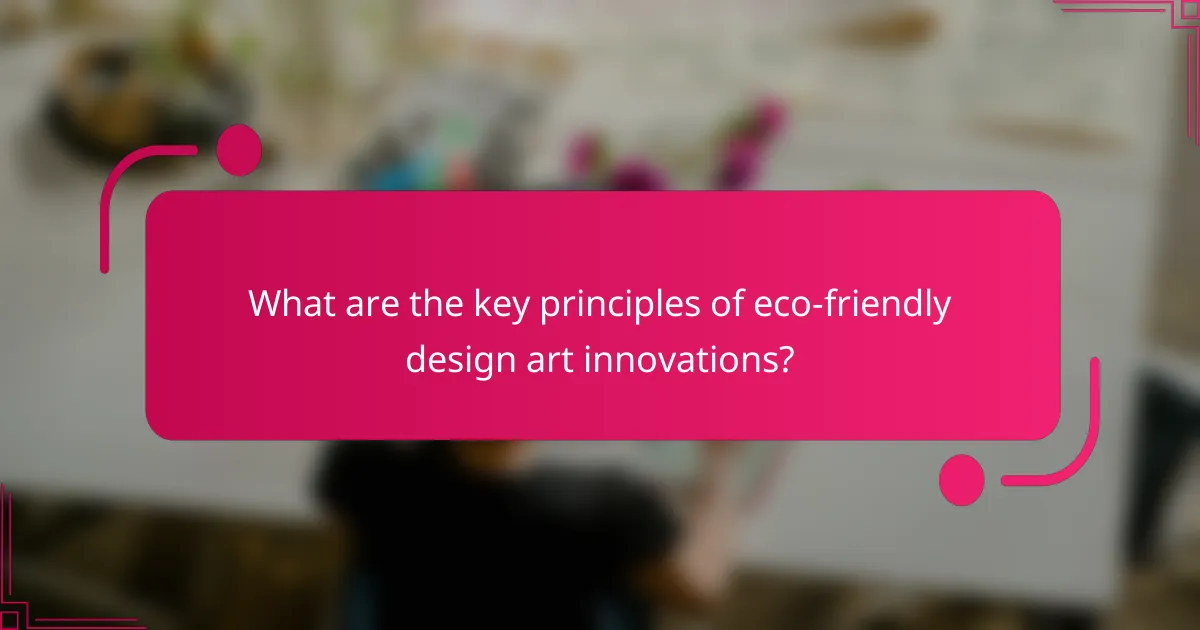
What are the key principles of eco-friendly design art innovations?
Eco-friendly design art innovations prioritise sustainability through techniques, materials, and impactful practices. Key principles include using recycled materials, minimising waste, and promoting energy efficiency. These innovations often utilise natural dyes and non-toxic adhesives, enhancing both aesthetic value and environmental responsibility. Additionally, they encourage community engagement and awareness about ecological issues, fostering a culture of sustainability in art.
How does sustainability influence artistic creativity?
Sustainability profoundly influences artistic creativity by inspiring innovative eco-friendly design techniques and materials. Artists increasingly integrate sustainable practices, utilising recycled materials and environmentally conscious processes. This shift not only enhances the aesthetic value of artworks but also promotes awareness of ecological issues. For example, artists are experimenting with biodegradable materials, which offer unique textures and forms, creating a distinct visual impact while minimising environmental harm. As a result, sustainability becomes a catalyst for originality and a deeper connection between art and nature.
Which design philosophies prioritise environmental impact?
Design philosophies that prioritise environmental impact include sustainable design, biomimicry, and circular design. These approaches focus on minimising waste, using renewable resources, and creating products that can be reused or recycled.
Sustainable design emphasises eco-friendly materials and energy-efficient processes. Biomimicry draws inspiration from nature to solve design challenges, promoting harmony with the environment. Circular design aims to create a closed-loop system, reducing the need for new materials and lessening environmental harm.
These philosophies collectively contribute to reducing ecological footprints and fostering a more sustainable future.
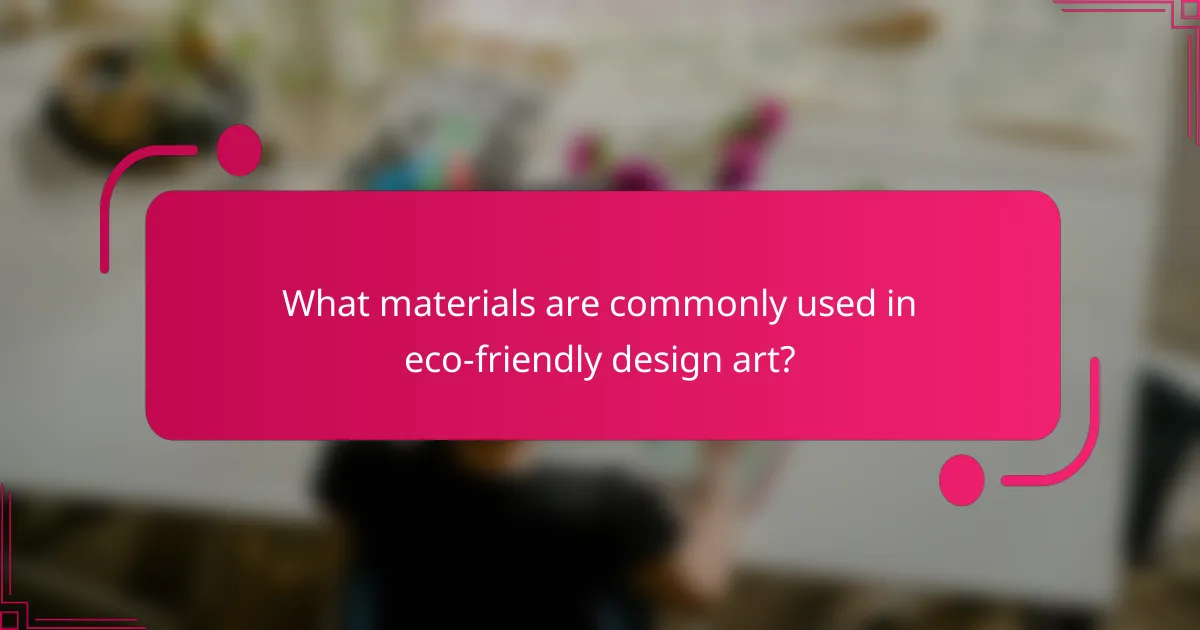
What materials are commonly used in eco-friendly design art?
Common materials used in eco-friendly design art include recycled paper, bamboo, reclaimed wood, organic fabrics, and biodegradable plastics. These materials promote sustainability and reduce environmental impact.
Recycled paper is often utilised for its low energy consumption during production. Bamboo is valued for its rapid growth and strength. Reclaimed wood provides a unique aesthetic while minimising deforestation. Organic fabrics, such as cotton and hemp, are grown without harmful chemicals. Biodegradable plastics offer an alternative to traditional plastics, breaking down naturally over time.
How do recycled materials enhance artistic expression?
Recycled materials enhance artistic expression by providing unique textures, colours, and stories. Artists utilise these materials to convey messages about sustainability and environmental awareness. For example, using reclaimed wood can add historical context to a piece, while plastic waste can transform into thought-provoking installations. This approach fosters creativity and innovation, encouraging viewers to reconsider their relationship with materials and waste.
Which natural materials are favoured by eco-conscious artists?
Eco-conscious artists favour natural materials like bamboo, recycled paper, organic cotton, and clay. These materials are sustainable, biodegradable, and often locally sourced, reducing environmental impact. Additionally, artists may use plant-based dyes and non-toxic adhesives, enhancing the eco-friendly aspect of their work.
What role do biodegradable materials play in design art?
Biodegradable materials significantly enhance design art by promoting sustainability and reducing environmental impact. These materials, such as bioplastics and organic textiles, are used to create innovative artworks that align with eco-friendly principles. Artists increasingly incorporate biodegradable elements to address climate change and encourage recycling. For example, using plant-based inks and natural fibres minimises waste and supports a circular economy. This approach not only reflects contemporary values but also inspires viewers to consider the environmental implications of their choices.

How do techniques in eco-friendly design art differ from traditional methods?
Eco-friendly design art techniques prioritise sustainability, utilising renewable materials and minimising waste, unlike traditional methods. Innovations include upcycled materials, eco-conscious production processes, and a focus on environmental impact. These techniques often incorporate local resources, reducing carbon footprints and promoting community engagement. The unique attribute of eco-friendly design is its adaptability to various artistic expressions while maintaining ecological integrity.
What innovative processes are being adopted by artists?
Artists are adopting innovative eco-friendly design processes that prioritise sustainability. Techniques include upcycling materials, using biodegradable substances, and integrating natural elements into artworks. For example, some artists create pieces from reclaimed wood or recycled plastics, reducing waste and environmental impact. These practices not only enhance creativity but also promote awareness of ecological issues. The impact of these innovations is significant, fostering a culture of sustainability in the art community and encouraging viewers to consider their environmental footprint.
How can technology improve eco-friendly design practices?
Technology enhances eco-friendly design practices by enabling innovative techniques and sustainable materials. Tools like 3D printing reduce waste and allow for complex, efficient designs. Digital simulations optimise resource use, while smart materials adapt to environmental conditions. These advancements promote a circular economy, minimising environmental impact.
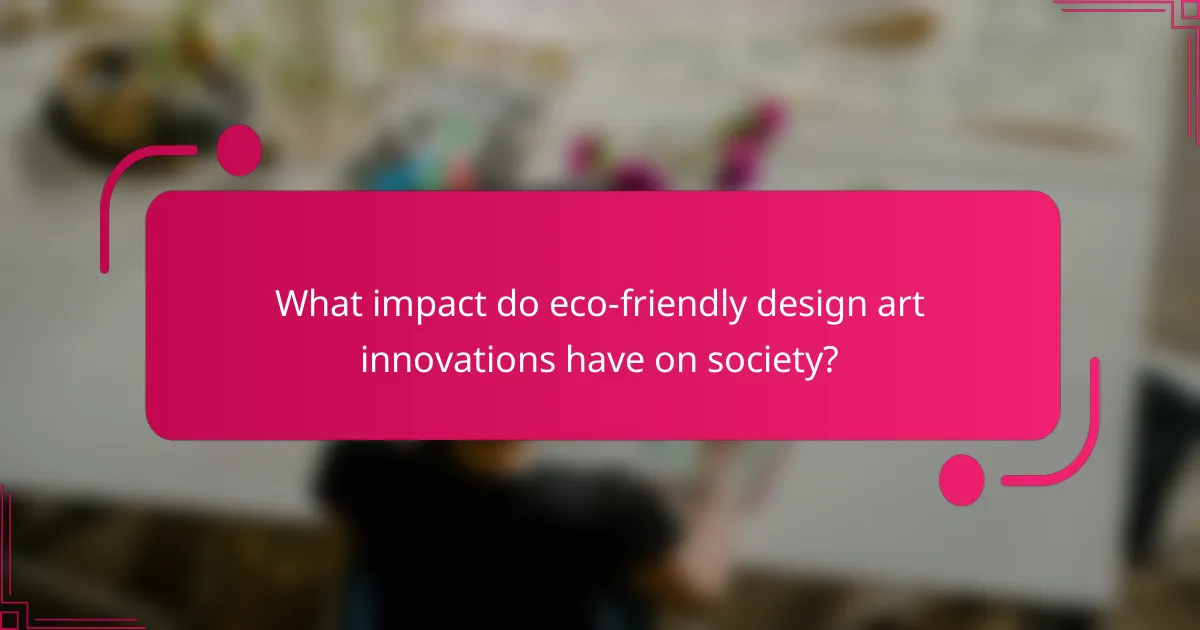
What impact do eco-friendly design art innovations have on society?
Eco-friendly design art innovations positively impact society by promoting sustainability and environmental awareness. These innovations use sustainable materials and techniques, reducing waste and resource consumption. They inspire communities to embrace eco-conscious practices, fostering a culture of sustainability. As a result, eco-friendly art encourages dialogue about environmental issues, driving social change and influencing future design trends.
How do these innovations promote environmental awareness?
Eco-friendly design art innovations enhance environmental awareness by using sustainable materials and techniques. These practices educate consumers about ecological issues and promote responsible consumption. For example, artists often incorporate recycled materials, highlighting waste reduction. Additionally, these innovations inspire community engagement through workshops and exhibitions that focus on environmental themes, fostering a collective responsibility towards nature. Such approaches not only create awareness but also encourage action towards sustainability in everyday life.
Which communities benefit most from sustainable art initiatives?
Communities that benefit most from sustainable art initiatives include low-income neighbourhoods, educational institutions, and indigenous groups. These initiatives foster environmental awareness, enhance local economies, and promote cultural heritage. For example, low-income neighbourhoods gain access to eco-friendly art projects that beautify public spaces and create jobs. Educational institutions implement sustainable art programs that teach students about environmental stewardship. Indigenous groups often use sustainable art to preserve and share their cultural narratives while advocating for environmental justice.
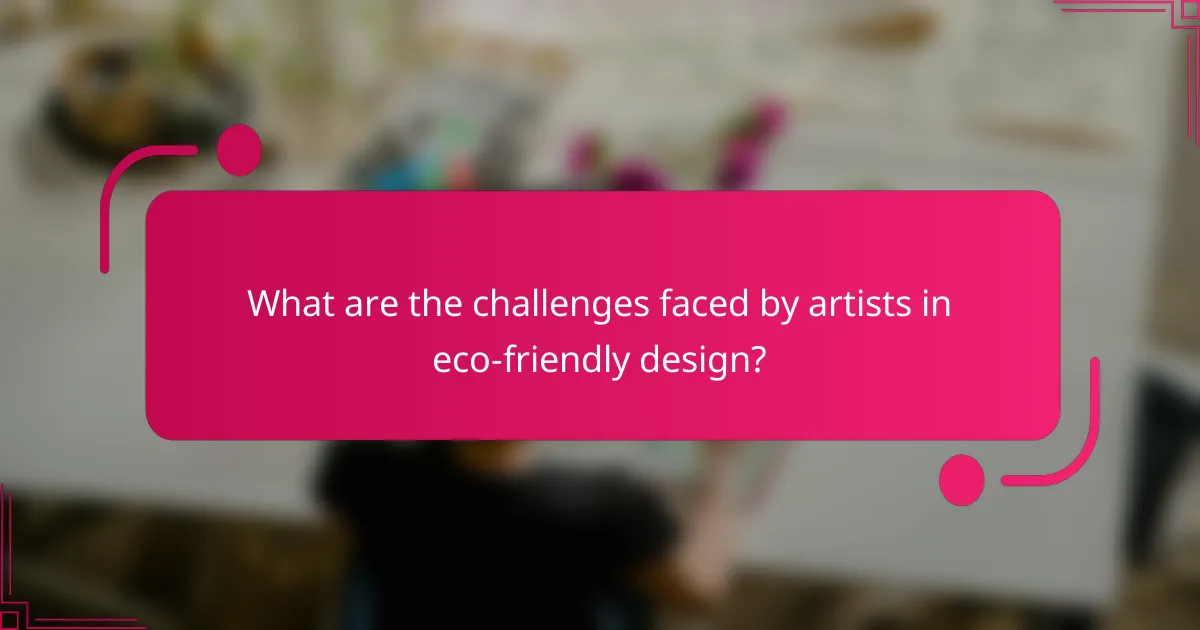
What are the challenges faced by artists in eco-friendly design?
Artists in eco-friendly design face challenges such as limited access to sustainable materials, higher costs, and the need for innovation. These constraints can hinder creativity and market acceptance. Additionally, balancing artistic expression with environmental responsibility often complicates the design process. The demand for eco-friendly art is growing, but artists must navigate these obstacles to succeed.
How does cost affect the adoption of sustainable materials?
Cost significantly impacts the adoption of sustainable materials by influencing accessibility and decision-making. Higher initial costs deter many businesses from transitioning to eco-friendly options. However, long-term savings and environmental benefits can offset these costs. For example, sustainable materials often lead to reduced energy consumption and waste management expenses over time. As consumers increasingly demand eco-friendly products, companies may find that investing in sustainable materials enhances their market competitiveness.
What barriers exist in the mainstream acceptance of eco-friendly art?
Mainstream acceptance of eco-friendly art faces several barriers. These include limited awareness among consumers, higher costs of sustainable materials, and traditional perceptions of art. Additionally, the art market often prioritises established practices over innovative techniques. The lack of education on the benefits of eco-friendly art further hinders its acceptance. Lastly, insufficient support from galleries and institutions restricts visibility and promotion of sustainable artists.
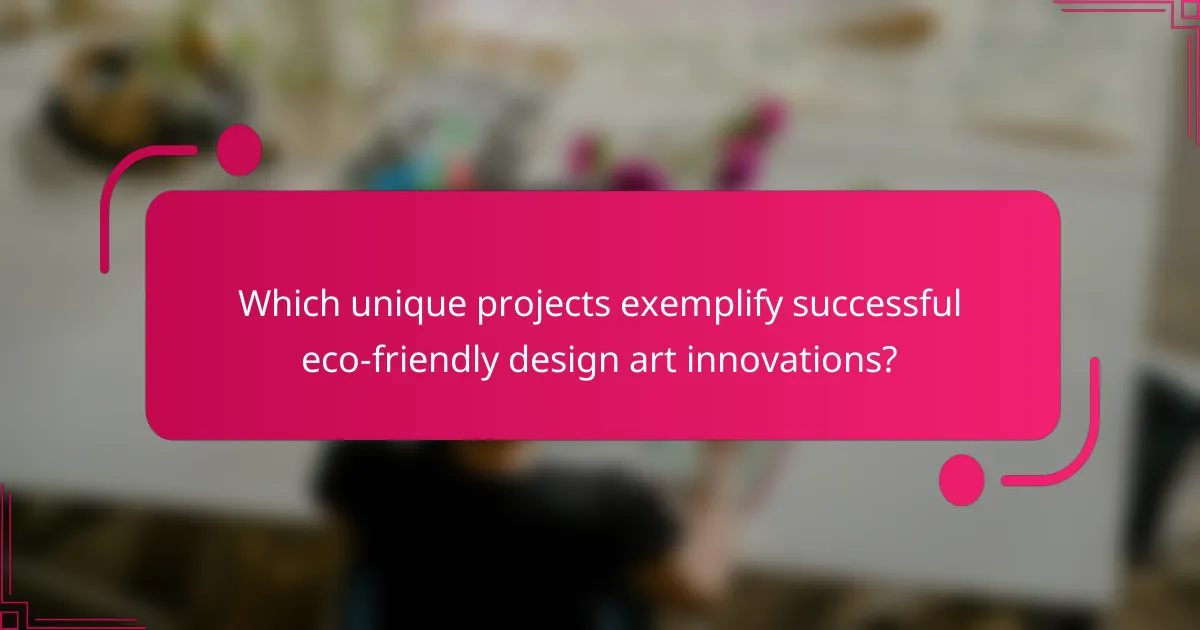
Which unique projects exemplify successful eco-friendly design art innovations?
Innovative eco-friendly design art projects include the Eden Project, the High Line, and the Green School. These projects exemplify sustainability through unique materials and techniques.
The Eden Project in the UK features biomes made from geodesic domes, utilising recycled materials to create a habitat for diverse plant species. The High Line in New York City transformed an abandoned railway into a green space, showcasing urban ecology and community engagement. The Green School in Bali integrates natural materials and renewable energy, emphasising education in sustainability.
These projects highlight the impact of eco-friendly design art innovations on communities and the environment, promoting awareness and inspiring future initiatives.
What local initiatives have gained recognition for sustainability in art?
Local initiatives recognised for sustainability in art include community art projects that utilise recycled materials and promote environmental awareness. These initiatives demonstrate innovative techniques and eco-friendly design, fostering a positive impact on both local culture and the environment. Examples include public murals made from repurposed materials and art installations that raise awareness about climate change. Such projects engage local artists and communities, emphasising the importance of sustainability in creative expression.
How do collaborative projects foster eco-friendly design solutions?
Collaborative projects significantly enhance eco-friendly design solutions by integrating diverse perspectives and expertise. This approach fosters innovation in materials and techniques that prioritise sustainability.
Working together, designers can share knowledge about environmentally friendly practices, leading to the development of unique attributes in their projects. For example, using reclaimed materials can reduce waste while creating distinctive designs. Collaborative efforts can also result in rare innovations, such as biomimetic designs inspired by nature, which effectively address environmental challenges.
Moreover, these projects often emphasise community involvement, ensuring that eco-friendly solutions meet local needs. This engagement not only boosts the impact of the designs but also raises awareness about sustainability, creating a ripple effect in the community.
In summary, collaboration in design promotes eco-friendly solutions through shared knowledge, innovative techniques, and community engagement, ultimately leading to a more sustainable future.
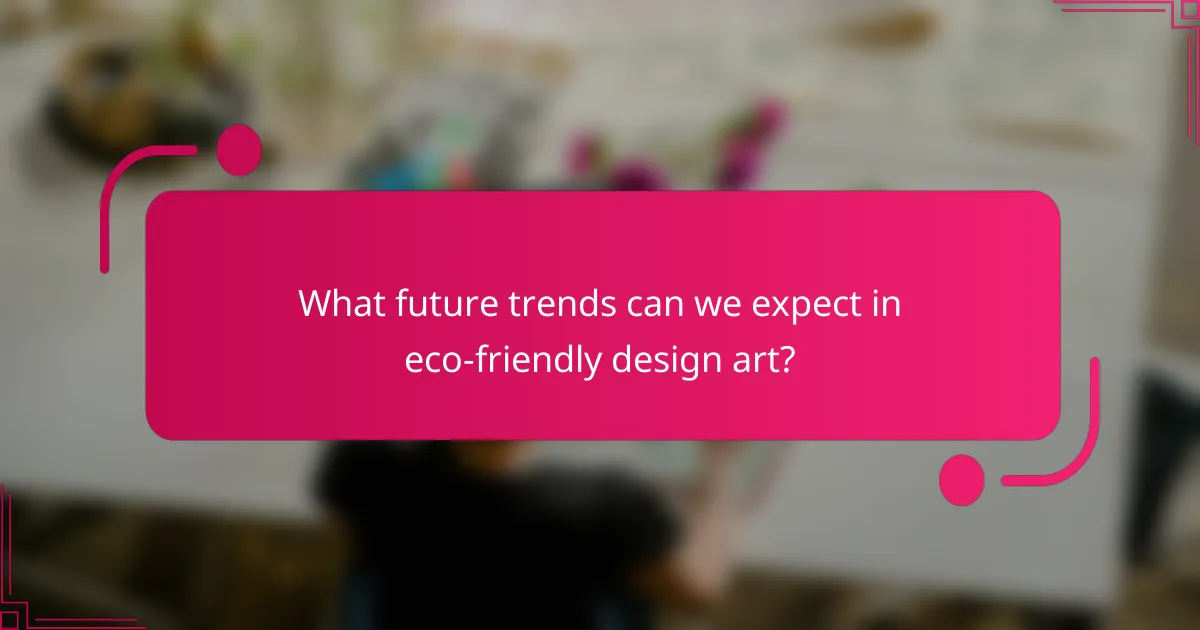
What future trends can we expect in eco-friendly design art?
Eco-friendly design art will increasingly focus on sustainable materials, innovative techniques, and social impact. Trends include the use of biodegradable materials, upcycling, and digital art forms that minimise waste. Artists are also prioritising community engagement, highlighting environmental issues through their work. As a result, eco-friendly design art will foster greater awareness and inspire action towards sustainability.
How will consumer preferences shape sustainable art movements?
Consumer preferences will increasingly drive sustainable art movements by prioritising eco-friendly materials and practices. Artists are adopting innovative techniques that minimise environmental impact, such as using recycled materials and natural pigments. This shift not only appeals to environmentally conscious buyers but also enhances the artistic narrative around sustainability.
As a result, art collectors and consumers are more inclined to support artists who align with their values, leading to a greater demand for sustainable artworks. This trend encourages the art community to explore unique attributes of eco-friendly design, such as the use of biodegradable materials and energy-efficient production methods. Consequently, the impact of consumer preferences is reshaping the landscape of contemporary art, fostering a culture of sustainability.
What role will education play in the evolution of eco-friendly design?
Education will play a crucial role in advancing eco-friendly design by fostering innovation and awareness. It equips designers with sustainable techniques and materials, enhancing their ability to create environmentally conscious solutions. For instance, integrating sustainability into design curricula emphasises the importance of reducing waste and utilising renewable resources. As a result, educated designers can drive impactful changes in industries, promoting eco-friendly practices that benefit both society and the environment. By prioritising sustainable education, future generations will be better prepared to tackle ecological challenges through innovative design.
What best practices should artists follow to enhance sustainability in their work?
Artists should prioritise sustainable practices by using eco-friendly materials, minimising waste, and adopting energy-efficient techniques. Incorporating recycled or natural materials reduces environmental impact. Utilising digital tools can lower resource consumption while promoting awareness of sustainability. Collaboration with environmentally conscious organisations enhances community engagement and amplifies impact.
